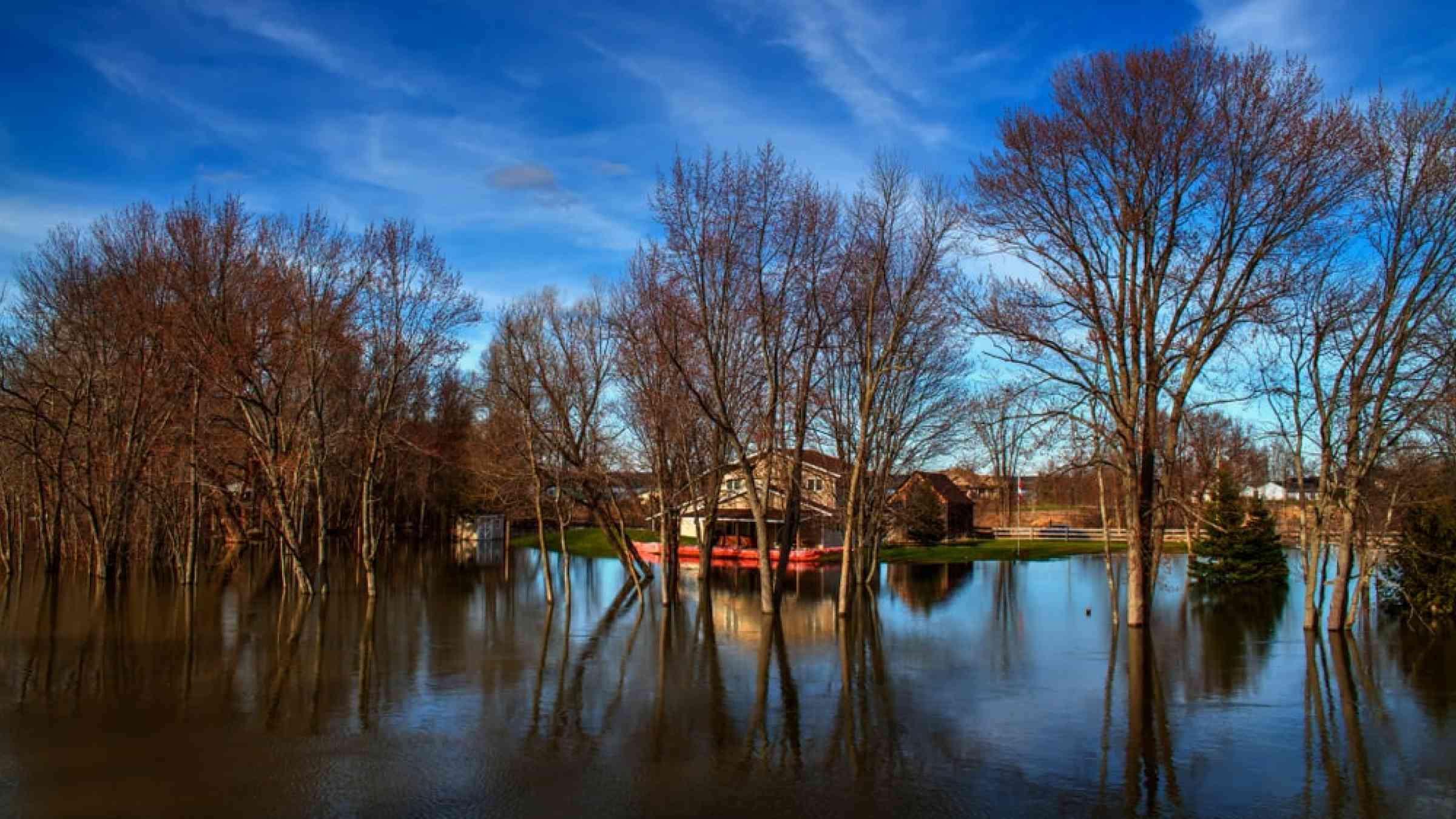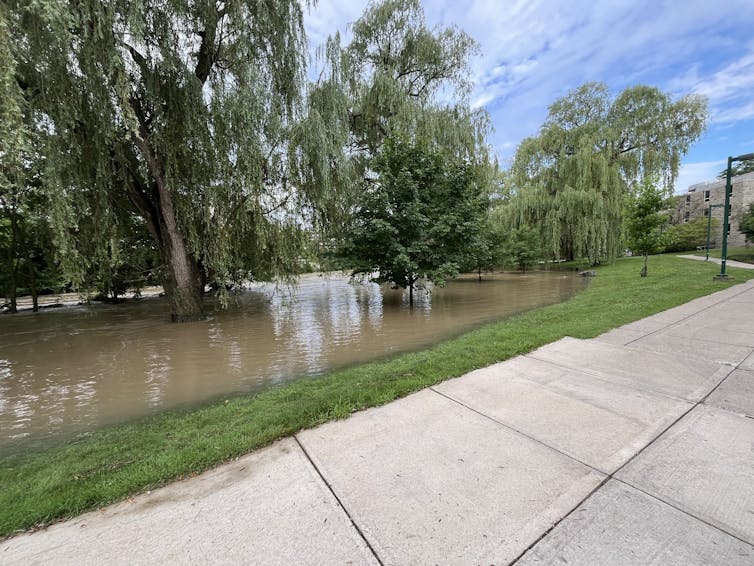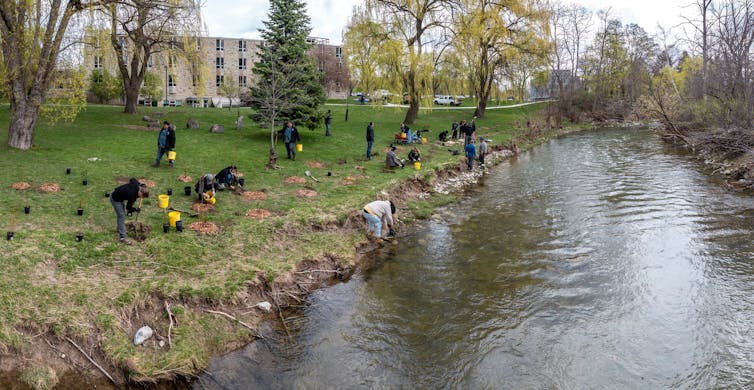Ontario floods: How nature-based solutions can promote effective flood management

This week, large areas of Ontario experienced severe flooding that caused widespread power outages, water damages and disruption. Severe rainfall events are not new, but they are becoming more frequent and costly due to human-caused climate change.
Flooding is a challenge affecting everything from economic security, to drinking water and the pursuit of truth and reconciliation. Canada must adapt to the urgent risks posed by worsening floods. Luckily, numerous pathways exist for individual Canadians to engage in collective actions to protect ourselves and our communities.
I learned the realities of flooding the hard way: by getting my socks wet when I stepped foot on my basement floor. Water from a pipe seeped behind the walls and under the waterproof floor. It caused damage that was, for a variety of reasons not covered by home insurance. However, I turned out lucky, all things considered. The average cost of a flooded basement in Canada is over $40,000.
Climate change is shifting how water moves through landscapes both in our communities and around the globe. Information and awareness is key in this world of changing conditions. However, a 2022 audit of flood risk preparedness in Ontario reported that public awareness of personal flood risk and liability is poor across the province.
Many Canadians are just one bad storm away from an unmitigated watery disaster. Floods are the most expensive and most frequent type of natural hazard in Canada. An analysis of insurance solutions for flood risk found that current residential flood risk in Canada is estimated at $2.9 billion per year.
Meanwhile, more homes in floodplain areas are becoming uninsurable due to increasing risk. Québec and Ontario have the greatest number of homes at high risk of flood damage in Canada and this number will continue to grow.
There is a widening gap in Ontario between spending on infrastructure by all levels of government, and the scale of investments required to bring public assets like roads and buildings up to a state of good repair. Amid budget crunches and pressure to keep taxes low, solutions for adapting infrastructure to climate change are still chronically underfunded.
Nature-based community driven solutions have huge potential to address gaps in infrastructure, promote resilience and build ecological knowledge - often at a much reduced cost than traditional hard solutions like seawalls or embankments.

An image of flooding at Western University in London, Ont. on July 17, 2024. (Brendon Samuels), CC BY
Perpetuating injustice
Besides damaging infrastructure, flooding causes a variety of harmful effects on water quality and human health. During storms and snowmelt, runoff conveys pollutants such as plastics, road salt, fertilizers and pesticides into watercourses.
Much of Canada's stormwater infrastructure was built back when urban centres were smaller and sewers had fewer connections. These older systems have limited capacity to cope with large surges.
When water levels suddenly rise, operators are left with no option but to release overflows into waterways. While necessary in the short term, these actions can have huge ecological impacts.
Where I live in London, Ont., wastewater treatment plants are connected to outdated sewers that combine water from storm drains with plumbing. During heavy storms, stormwater polluted with sewage wastewater overflows into the Thames River.
Downriver from London, Oneida Nation of the Thames and Chippewas of the Thames First Nation have suffered under boil water advisories since 2019 and 2021 because of contamination of their traditional water source.
Working with nature
A recent report by the Financial Accountability Office of Ontario reviewed budgetary impacts of climate change hazards on public infrastructure. It estimated that proactive adaptation could save $1.1 billion per year.
Nature-based solutions - or green infrastructure - are an effective proactive technique which can be implemented close to home. Techniques to mitigate floods include using vegetation to reduce runoff by soaking rain into the ground instead of it flowing into sewers or basements.
For example, in 2022 I installed a - fully permitted - rain garden whose deep-rooted native plants receive and absorb rainwater that may have otherwise made its way into my basement.
Green infrastructure can also be highly effective along watercourses where, once established, vegetation helps to filter surface pollutants, stabilize erosion and prevent surges of water from spilling over.
Low impact development techniques such as bioswales and permeable pavement can be used in combination with grey infrastructure to help reduce surface flooding in cities like Toronto.
Later that year, I applied for a small research grant from my university to lead a team carrying out ecological restoration along a creek bank on campus.
We held planting workshops in partnerships with the university, the conservation authority and community members from Chippewas of the Thames and Oneida First Nations. London's municipal government and public library further helped to tell our story.
Supporting resiliency
In a new study, my coauthors and I describe how the process of implementing nature-based solutions can build cross-cultural ecological knowledge and create opportunities for participants to take direct action on climate change. Critically, community involvement in creating green infrastructure helped ensure sustained interest in its stewardship.
Our collaboration supported public education through seminars and a dedicated webpage. These resources promote individual actions to coexist with water, such as flood-proofing homes and adapting landscaping.

A community-led initiative at Western University demonstrates how restoring vegetation along watercourses helps to mitigate floods. (Brendon Samuels), CC BY
This project demonstrates how partnerships can enhance environmental and social benefits of climate change adaptation projects.
We encourage higher education institutions and municipalities to support resiliency by engaging the public in applying nature-based solutions like naturalized buffers along watercourses, and to include Indigenous perspectives in management of land and water resources.
It is time we stop viewing nature as a threat to be held at bay and allow our environments to be an ally in the work to build a more resilient future.
![]()